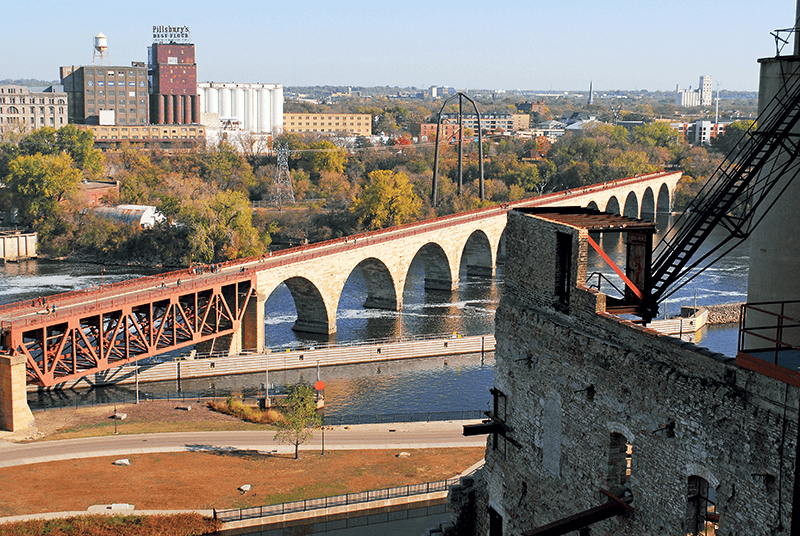The venerable James J. Hill Stone Arch Bridge is due for some repair and maintenance, as outlined in a March 19 virtual presentation by the Minnesota Department of Transportation (MnDOT). Jesse Johnson, MnDOT West Area communications and engagement manager, described the tasks involved: Repairing or replacing stones to match the original design; repairing the mortar on the entire bridge, conducting work below the waterline and making additional repairs as needed.
Johnson stressed that no work on the pedestrian level is anticipated, noting that there should be at least 20 more years before any surface repair is necessary. Most of the preconstruction tasks (stone measurements, clearing of vegetation and bringing equipment and materials to the site) are done. Anticipated working hours will be 7 a.m. to 7 p.m. Monday through Friday and every other Saturday. The project is expected to take approximately 18 months.
Work will begin in mid-April, with the closing of the east side of the bridge; no pedestrian traffic will be allowed on that side until work below the walkway is complete. At that time (likely Spring 2025) the east half will be open to pedestrians, and the west side will be closed. Major Projects Manager Amber Blanchard said, “I’ve had the pleasure and honor of working on this bridge for the last almost nine years.This bridge has been around for 140 years, and we want to make sure it’s around for another 140 years.”
Blanchard explained the reason for the split construction staging: “The team was concerned about the interaction between the contractor’s workers and MnDOT inspectors, as well as the public being right next to them as they’re working. We wanted to allow the contractor enough room to do work and stage materials on top of the bridge as needed, and while the bridge is wide enough for walking and biking, it is not necessarily wide enough for the work and equipment as well. We decided to basically slice the bridge in two and work on one side and then the other side.”
She added that the greater length of the east side and more work needed beneath its piers will require more time than the west side. Another project goal is to retain as much of the original bridge materials as possible.
For the last 30 years, the bridge has been for the exclusive use of pedestrians and cyclists following an extensive 1994 rehab that included crack and structural truss repair, removal of rock ballast at the arch walls, a new drainage system, bike lanes, metal safety rails and light posts on the bridge’s deck. But it spent its first hundred or so years as a 2,100-foot, twin-track railroad bridge, completed in 1883 to carry the Minneapolis Union Railroad to the west bank of the Mississippi River.
At its peak, it carried more than 80 passenger trains per day. The bridge had 23 limestone arches with 40- to 97-foot spans (two of the arches were replaced by a deck truss in 1962 to allow larger boats using the newly completed Upper Lock and Dam to pass through).
Freight traffic ended in 1965, and the last passenger cars left in 1978. The rail line was abandoned in 1987, and in 1992, the State Legislature transferred ownership to MnDOT, after which it was converted to pedestrian use and became part of the St. Anthony Falls Heritage Trail.
The bridge is located within the St. Anthony Falls Historic District and is designated a National Historic Engineering Landmark. It was placed on the National Register of Historic Places in 1971. The 1994 renovation received several honors, including a 1995 award from the Minneapolis Heritage Preservation Commission and the Minneapolis Chapter of the American Institute of Architects, as well as a 1996 “Design for Transportation National Award” from the U.S. Department of Transportation.
The MnDOT group addressed several questions sent in by viewers. Asked about detours, Construction Supervisor Bob Bobleter said they would be minimal, mostly at a cul-de-sac at 6th Avenue SE on the St. Anthony Main side (Main Street SE will remain open), and there will be signage at both ends of the bridge. To a question about Fourth of July fireworks, Johnson said the fireworks displays would return to the Third Avenue Bridge, where they had long been held before that bridge’s recently-completed restoration work.
Asked about barriers placed to prevent cars from driving on the bridge during construction, Johnson said that the bridge must be kept open for the use of emergency vehicles; as for other security measures, he noted that there is nothing planned at this point, “But there very well could be in the future.”

Repairs on the 141-year-old Stone Arch Bridge, seen here from the west bank of the river, will begin this month and continue through 2025. Pedestrians will not have access to the east side of the bridge this summer. (Mark Peterson)